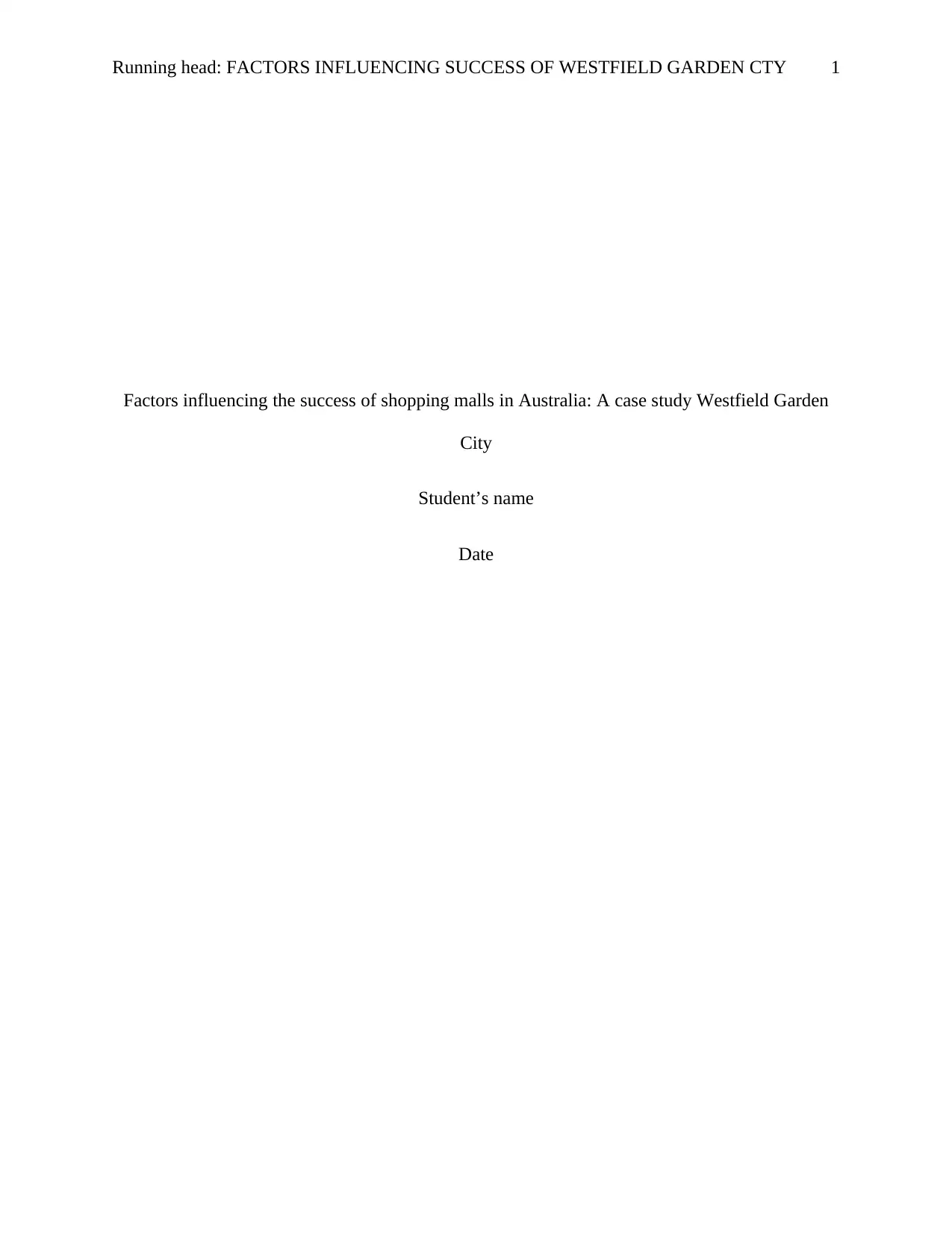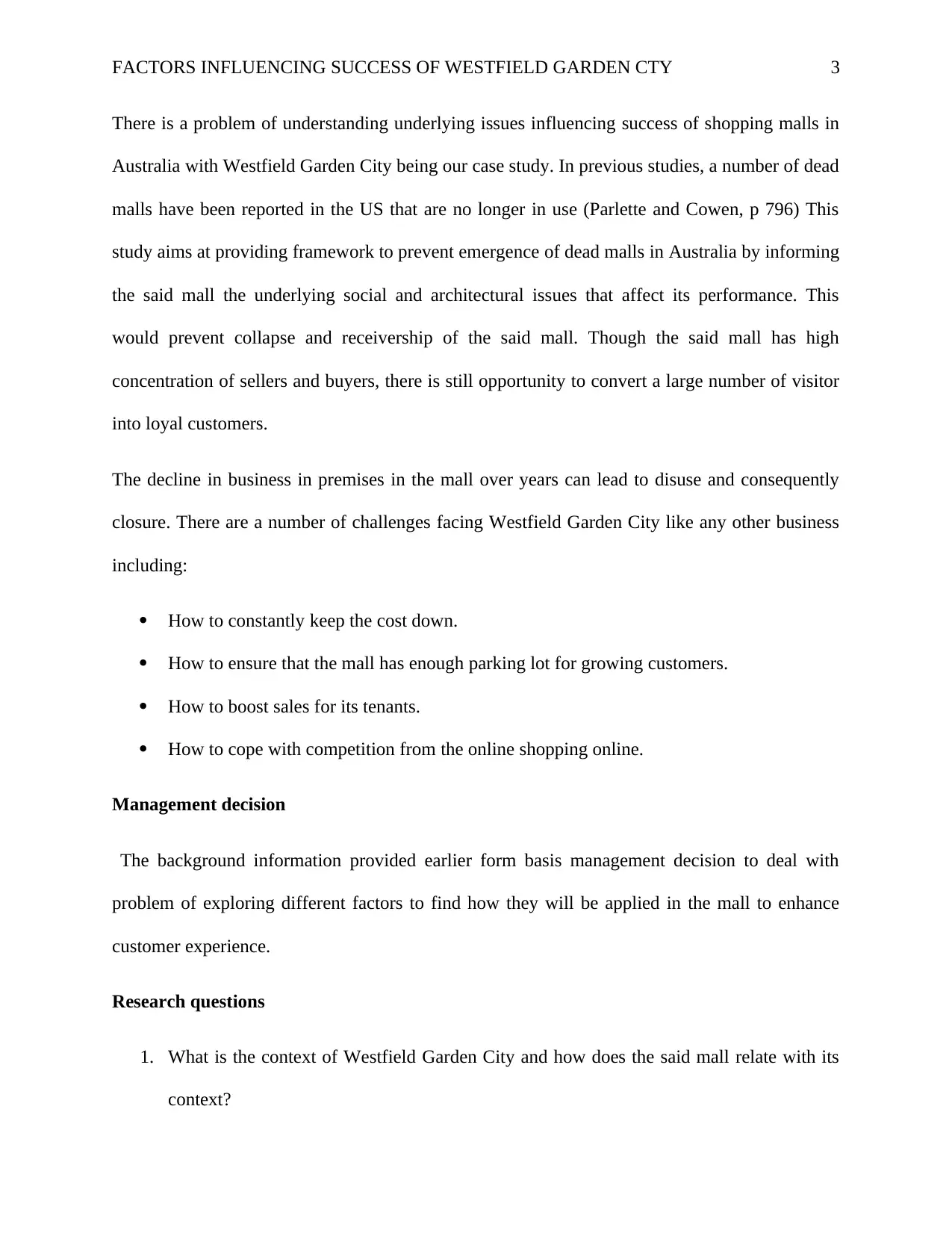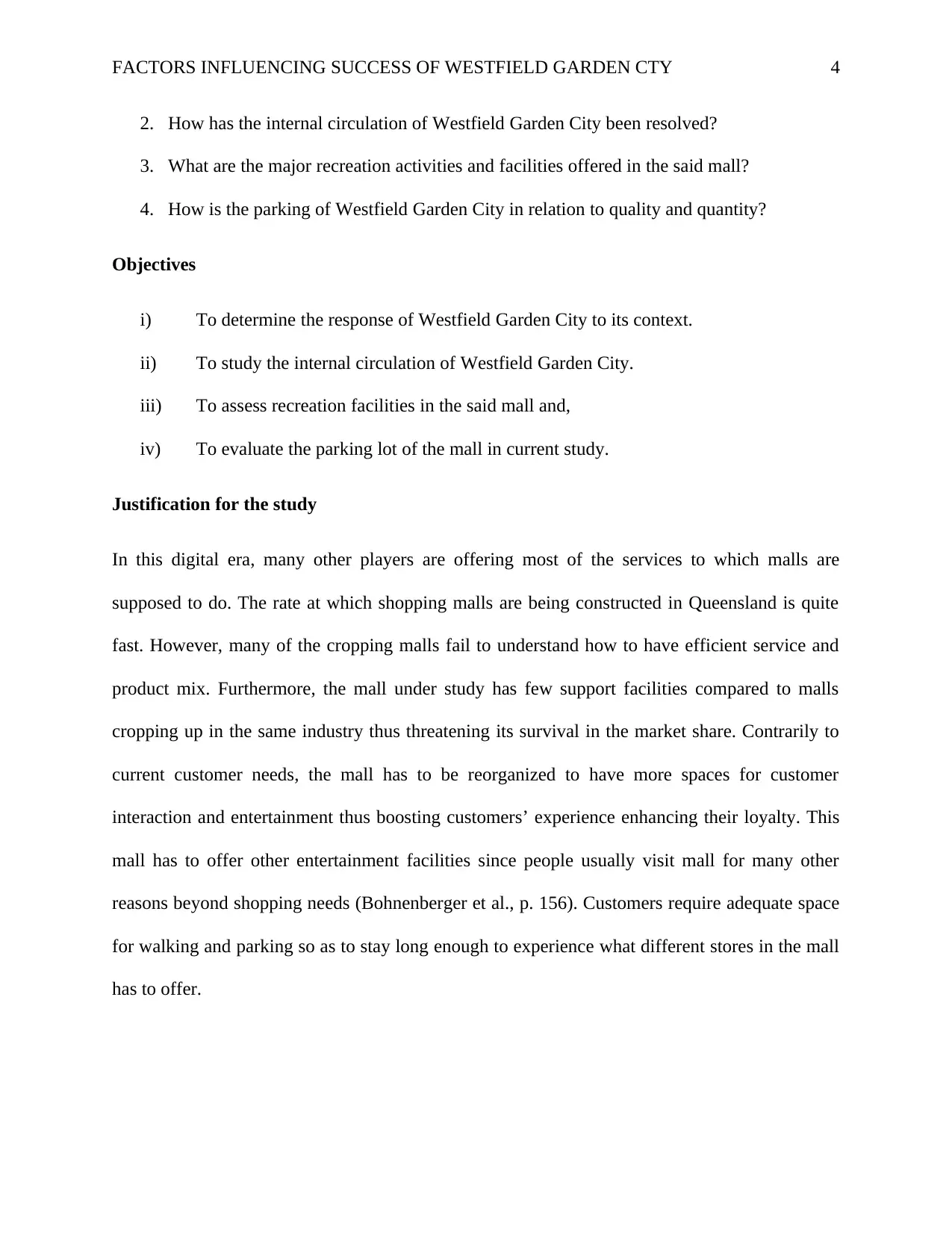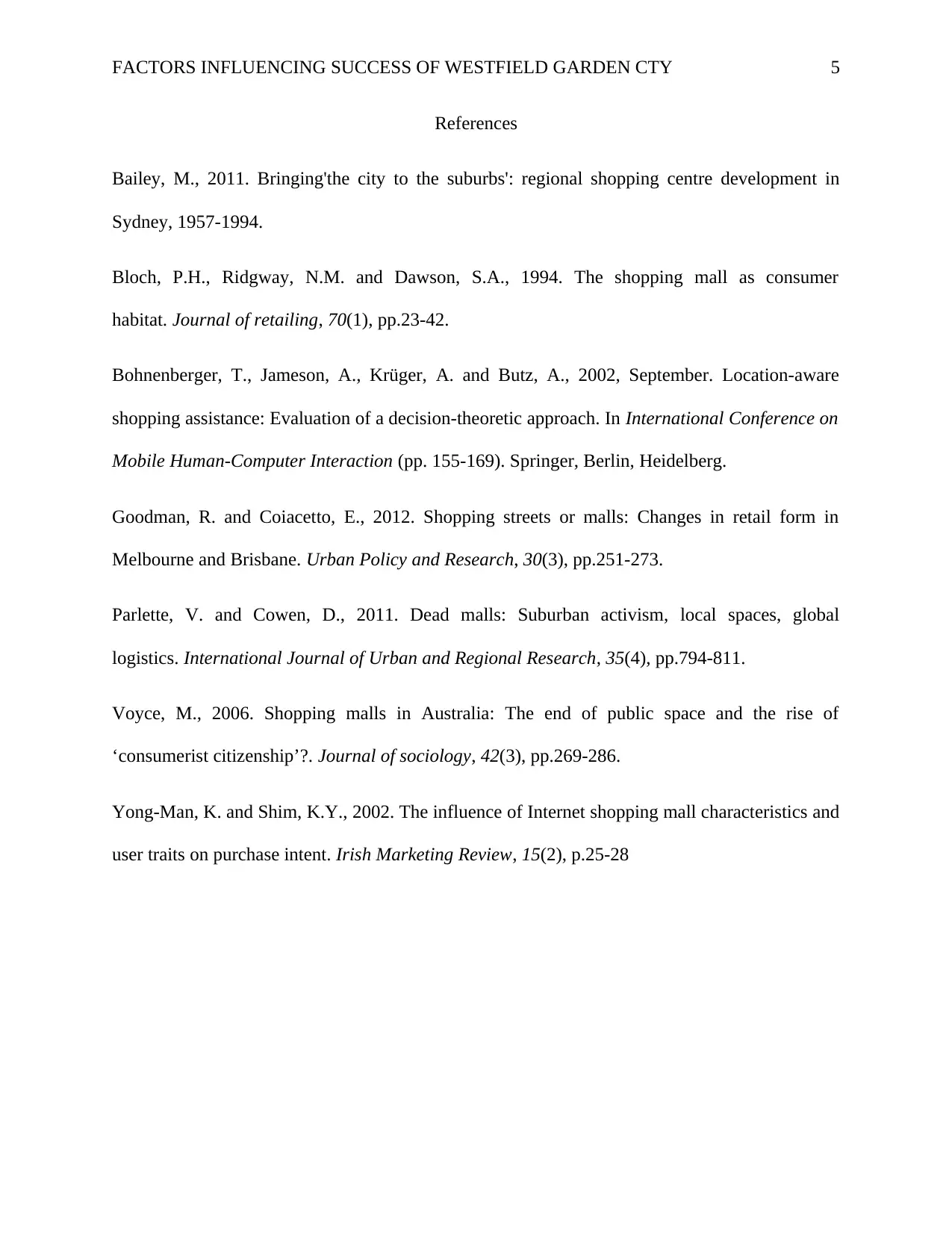Success Factors of Shopping Malls in Australia: Westfield Garden City
VerifiedAdded on 2023/06/13
|5
|1166
|341
Report
AI Summary
This report examines the factors influencing the success of shopping malls in Australia, using Westfield Garden City as a case study. It addresses the background problem of increasing competition and the need to prevent the decline of physical malls in the face of online shopping. The report identifies key research questions related to the mall's context, internal circulation, recreation facilities, and parking. It aims to provide insights that can inform management decisions and enhance customer experience, ensuring the mall's continued success and relevance in the evolving retail landscape. The study reviews existing literature to understand the dynamics of shopping malls and their impact on consumer behavior and urban spaces.

Running head: FACTORS INFLUENCING SUCCESS OF WESTFIELD GARDEN CTY 1
Factors influencing the success of shopping malls in Australia: A case study Westfield Garden
City
Student’s name
Date
Factors influencing the success of shopping malls in Australia: A case study Westfield Garden
City
Student’s name
Date
Paraphrase This Document
Need a fresh take? Get an instant paraphrase of this document with our AI Paraphraser

FACTORS INFLUENCING SUCCESS OF WESTFIELD GARDEN CTY 2
Introduction
The business organizations have revolutionized business operations to maximize customer
satisfaction by diversifying goods and service. A mall is defined as set of buildings having
several units with pathways to enable easily access different units (Bloch, Ridgway and Dawson,
p. 23). The shopping malls have certain features that attract people including having restaurants,
stores and other businesses that serves general public (Yong-Man and Shim, p. 25) Shopping
malls can also serve a major recreation centre where people meet to shop, make friends and
engage in other recreation activities. Westfield Garden City is one of the major shopping centres
in Brisbane having more than 400 stores hosting restaurants, retail shops, public library, cinema
and many other service vendors (Goodman and Coiacetto, p. 253). The shopping mall has
undergone tremendous changes since it construction in early 1970s however, the company is
facing a number of threats as explained in the problem definition section below.
Background to the problem
The Australian businesses have changed in the past few years characterized by cropping of many
shopping centres in the major cities (Voyce, p. 272). With Brisbane being one of the major cities
in the country, the number of malls are increasing significantly here. Westfield Garden City is
one of the popular shopping mall in Queensland thus enjoying a daily high traffic of customers
(Bailey, p. 1958). One can argue that the business success of this mall is attributed to quality of
shopping experience offered by multiple business unit in the mall. Though there are a number of
malls in Queensland including Robina Town Centre, Greek Road Carindale, Sunshine Plaza and
Harbour Town among others, the high quality of spaces in Westfield Garden City has increased
popularity of the said mall.
Introduction
The business organizations have revolutionized business operations to maximize customer
satisfaction by diversifying goods and service. A mall is defined as set of buildings having
several units with pathways to enable easily access different units (Bloch, Ridgway and Dawson,
p. 23). The shopping malls have certain features that attract people including having restaurants,
stores and other businesses that serves general public (Yong-Man and Shim, p. 25) Shopping
malls can also serve a major recreation centre where people meet to shop, make friends and
engage in other recreation activities. Westfield Garden City is one of the major shopping centres
in Brisbane having more than 400 stores hosting restaurants, retail shops, public library, cinema
and many other service vendors (Goodman and Coiacetto, p. 253). The shopping mall has
undergone tremendous changes since it construction in early 1970s however, the company is
facing a number of threats as explained in the problem definition section below.
Background to the problem
The Australian businesses have changed in the past few years characterized by cropping of many
shopping centres in the major cities (Voyce, p. 272). With Brisbane being one of the major cities
in the country, the number of malls are increasing significantly here. Westfield Garden City is
one of the popular shopping mall in Queensland thus enjoying a daily high traffic of customers
(Bailey, p. 1958). One can argue that the business success of this mall is attributed to quality of
shopping experience offered by multiple business unit in the mall. Though there are a number of
malls in Queensland including Robina Town Centre, Greek Road Carindale, Sunshine Plaza and
Harbour Town among others, the high quality of spaces in Westfield Garden City has increased
popularity of the said mall.

FACTORS INFLUENCING SUCCESS OF WESTFIELD GARDEN CTY 3
There is a problem of understanding underlying issues influencing success of shopping malls in
Australia with Westfield Garden City being our case study. In previous studies, a number of dead
malls have been reported in the US that are no longer in use (Parlette and Cowen, p 796) This
study aims at providing framework to prevent emergence of dead malls in Australia by informing
the said mall the underlying social and architectural issues that affect its performance. This
would prevent collapse and receivership of the said mall. Though the said mall has high
concentration of sellers and buyers, there is still opportunity to convert a large number of visitor
into loyal customers.
The decline in business in premises in the mall over years can lead to disuse and consequently
closure. There are a number of challenges facing Westfield Garden City like any other business
including:
How to constantly keep the cost down.
How to ensure that the mall has enough parking lot for growing customers.
How to boost sales for its tenants.
How to cope with competition from the online shopping online.
Management decision
The background information provided earlier form basis management decision to deal with
problem of exploring different factors to find how they will be applied in the mall to enhance
customer experience.
Research questions
1. What is the context of Westfield Garden City and how does the said mall relate with its
context?
There is a problem of understanding underlying issues influencing success of shopping malls in
Australia with Westfield Garden City being our case study. In previous studies, a number of dead
malls have been reported in the US that are no longer in use (Parlette and Cowen, p 796) This
study aims at providing framework to prevent emergence of dead malls in Australia by informing
the said mall the underlying social and architectural issues that affect its performance. This
would prevent collapse and receivership of the said mall. Though the said mall has high
concentration of sellers and buyers, there is still opportunity to convert a large number of visitor
into loyal customers.
The decline in business in premises in the mall over years can lead to disuse and consequently
closure. There are a number of challenges facing Westfield Garden City like any other business
including:
How to constantly keep the cost down.
How to ensure that the mall has enough parking lot for growing customers.
How to boost sales for its tenants.
How to cope with competition from the online shopping online.
Management decision
The background information provided earlier form basis management decision to deal with
problem of exploring different factors to find how they will be applied in the mall to enhance
customer experience.
Research questions
1. What is the context of Westfield Garden City and how does the said mall relate with its
context?
⊘ This is a preview!⊘
Do you want full access?
Subscribe today to unlock all pages.

Trusted by 1+ million students worldwide

FACTORS INFLUENCING SUCCESS OF WESTFIELD GARDEN CTY 4
2. How has the internal circulation of Westfield Garden City been resolved?
3. What are the major recreation activities and facilities offered in the said mall?
4. How is the parking of Westfield Garden City in relation to quality and quantity?
Objectives
i) To determine the response of Westfield Garden City to its context.
ii) To study the internal circulation of Westfield Garden City.
iii) To assess recreation facilities in the said mall and,
iv) To evaluate the parking lot of the mall in current study.
Justification for the study
In this digital era, many other players are offering most of the services to which malls are
supposed to do. The rate at which shopping malls are being constructed in Queensland is quite
fast. However, many of the cropping malls fail to understand how to have efficient service and
product mix. Furthermore, the mall under study has few support facilities compared to malls
cropping up in the same industry thus threatening its survival in the market share. Contrarily to
current customer needs, the mall has to be reorganized to have more spaces for customer
interaction and entertainment thus boosting customers’ experience enhancing their loyalty. This
mall has to offer other entertainment facilities since people usually visit mall for many other
reasons beyond shopping needs (Bohnenberger et al., p. 156). Customers require adequate space
for walking and parking so as to stay long enough to experience what different stores in the mall
has to offer.
2. How has the internal circulation of Westfield Garden City been resolved?
3. What are the major recreation activities and facilities offered in the said mall?
4. How is the parking of Westfield Garden City in relation to quality and quantity?
Objectives
i) To determine the response of Westfield Garden City to its context.
ii) To study the internal circulation of Westfield Garden City.
iii) To assess recreation facilities in the said mall and,
iv) To evaluate the parking lot of the mall in current study.
Justification for the study
In this digital era, many other players are offering most of the services to which malls are
supposed to do. The rate at which shopping malls are being constructed in Queensland is quite
fast. However, many of the cropping malls fail to understand how to have efficient service and
product mix. Furthermore, the mall under study has few support facilities compared to malls
cropping up in the same industry thus threatening its survival in the market share. Contrarily to
current customer needs, the mall has to be reorganized to have more spaces for customer
interaction and entertainment thus boosting customers’ experience enhancing their loyalty. This
mall has to offer other entertainment facilities since people usually visit mall for many other
reasons beyond shopping needs (Bohnenberger et al., p. 156). Customers require adequate space
for walking and parking so as to stay long enough to experience what different stores in the mall
has to offer.
Paraphrase This Document
Need a fresh take? Get an instant paraphrase of this document with our AI Paraphraser

FACTORS INFLUENCING SUCCESS OF WESTFIELD GARDEN CTY 5
References
Bailey, M., 2011. Bringing'the city to the suburbs': regional shopping centre development in
Sydney, 1957-1994.
Bloch, P.H., Ridgway, N.M. and Dawson, S.A., 1994. The shopping mall as consumer
habitat. Journal of retailing, 70(1), pp.23-42.
Bohnenberger, T., Jameson, A., Krüger, A. and Butz, A., 2002, September. Location-aware
shopping assistance: Evaluation of a decision-theoretic approach. In International Conference on
Mobile Human-Computer Interaction (pp. 155-169). Springer, Berlin, Heidelberg.
Goodman, R. and Coiacetto, E., 2012. Shopping streets or malls: Changes in retail form in
Melbourne and Brisbane. Urban Policy and Research, 30(3), pp.251-273.
Parlette, V. and Cowen, D., 2011. Dead malls: Suburban activism, local spaces, global
logistics. International Journal of Urban and Regional Research, 35(4), pp.794-811.
Voyce, M., 2006. Shopping malls in Australia: The end of public space and the rise of
‘consumerist citizenship’?. Journal of sociology, 42(3), pp.269-286.
Yong-Man, K. and Shim, K.Y., 2002. The influence of Internet shopping mall characteristics and
user traits on purchase intent. Irish Marketing Review, 15(2), p.25-28
References
Bailey, M., 2011. Bringing'the city to the suburbs': regional shopping centre development in
Sydney, 1957-1994.
Bloch, P.H., Ridgway, N.M. and Dawson, S.A., 1994. The shopping mall as consumer
habitat. Journal of retailing, 70(1), pp.23-42.
Bohnenberger, T., Jameson, A., Krüger, A. and Butz, A., 2002, September. Location-aware
shopping assistance: Evaluation of a decision-theoretic approach. In International Conference on
Mobile Human-Computer Interaction (pp. 155-169). Springer, Berlin, Heidelberg.
Goodman, R. and Coiacetto, E., 2012. Shopping streets or malls: Changes in retail form in
Melbourne and Brisbane. Urban Policy and Research, 30(3), pp.251-273.
Parlette, V. and Cowen, D., 2011. Dead malls: Suburban activism, local spaces, global
logistics. International Journal of Urban and Regional Research, 35(4), pp.794-811.
Voyce, M., 2006. Shopping malls in Australia: The end of public space and the rise of
‘consumerist citizenship’?. Journal of sociology, 42(3), pp.269-286.
Yong-Man, K. and Shim, K.Y., 2002. The influence of Internet shopping mall characteristics and
user traits on purchase intent. Irish Marketing Review, 15(2), p.25-28
1 out of 5
Your All-in-One AI-Powered Toolkit for Academic Success.
+13062052269
info@desklib.com
Available 24*7 on WhatsApp / Email
![[object Object]](/_next/static/media/star-bottom.7253800d.svg)
Unlock your academic potential
Copyright © 2020–2025 A2Z Services. All Rights Reserved. Developed and managed by ZUCOL.

